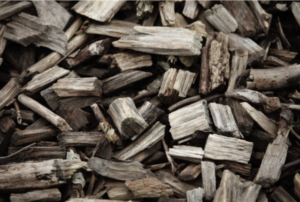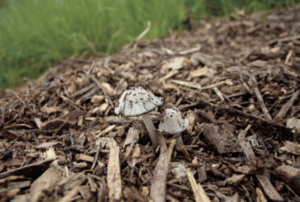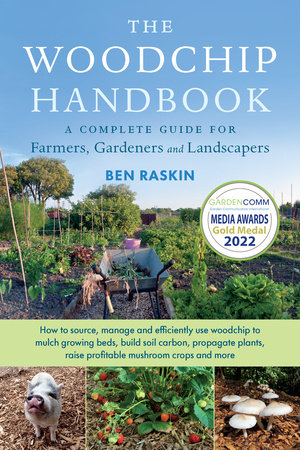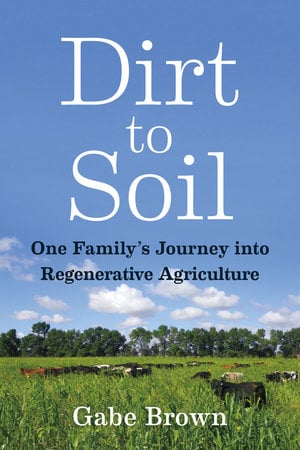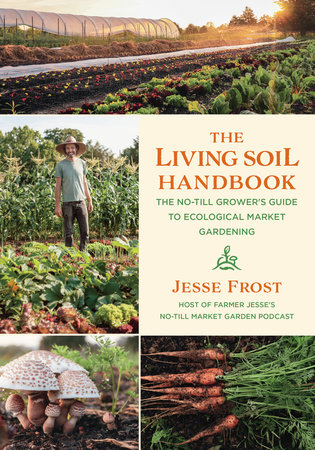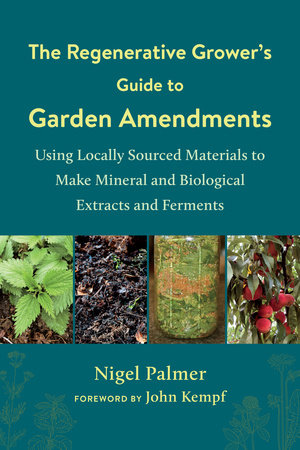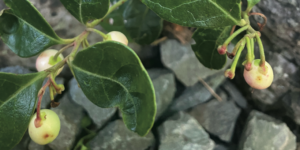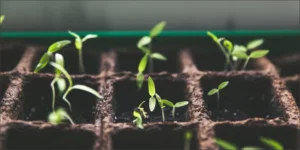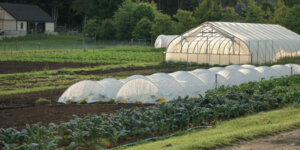5 Uses for the Mighty Woodchip
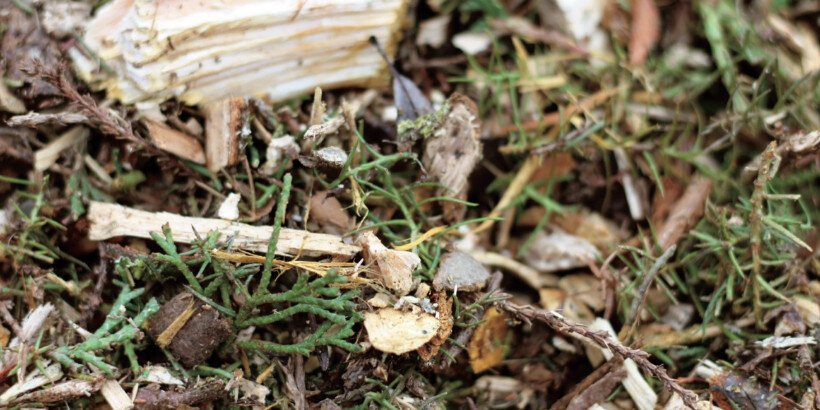
Very often, the best things come in small packages, and the humble woodchip is no exception.
We’re all familiar with the use of woodchips in mulch, and while they are an excellent mulching material, woodchips have many other uses. Think mushroom growing material and animal bedding; think plant propagation and soil amendments — the list goes on. Ben Raskin gives a rundown of the woodchip’s many uses — and he would know, he wrote the book on woodchips (literally, it’s the only book entirely devoted to woodchips!)
The following is an excerpt from The Woodchip Handbook by Ben Raskin. It has been adapted for the web.
1. Mulching
Mulching is the most common and best-understood use for woodchip in horticulture. Though occasionally abused in municipal planting or with artificially coloured chip, we get a whole range of benefits from adding woodchip as a surface covering to soil. There are risks, of course, and making sure we use the right material in the right situation is important. Let’s briefly run through some of woodchip mulch’s superpowers.
WEED CONTROL
Covering soil with a material free of weed seed that cuts out light will almost entirely eliminate annual weeds from your soil surface. It can also weaken some perennial weeds or at least make them easier to remove. Since weeding is one of the most time-consuming jobs in horticulture, especially in wetter climates, we can see why mulches are an attractive option.
There are a whole range of materials that can be used in this way: cardboard, sterile compost and plastic mulches (woven or solid). An organic material used for this purpose, like compost or woodchip, needs to be at least 5 centimetres (2 inches) thick and allows us to mulch irregular-shaped areas and go right up to plants, which is not easy using plastic or rigid materials. However, the cost of applying mulch for larger areas means that many commercial growers have tended to use plastic alternatives. Though plastic mulches can work on perennial plants and trees, they tend to be very hard to remove from the system once they begin to break down. The risks of plastic contamination of soil are beginning to be more understood, and since the type and condition of mulch plastic is not easily recycled many growers are now looking for environmentally sympathetic alternatives. Biodegradable plastics have been around for a while. I was using them twenty years ago as a grower, and they have improved in quality since then. They are, however, more effective if you have the scale to invest in specialist laying equipment and mainly have a relatively short life, so they are most suited to crops that only need weed protection for a few months.
In woodchip mulches, the species, size and age of chip will determine how effective and long lasting the mulch is. Smaller chip size is more effective at holding moisture but will break down quicker; similarly, older chips that are already partly broken down will not last as long as fresher material. Imagine, too, how easy it is for windblown seed to germinate on a mulch. Soft, partially composted chip is an ideal surface for seeds to grow on, while larger chips will prevent germination. One is not necessarily better than the other but will be more suited to different situations. For mulching no-dig vegetable beds I would choose a well-rotted fine grade, while for shrubs and trees a larger-sized chip, less broken down, would be more effective.
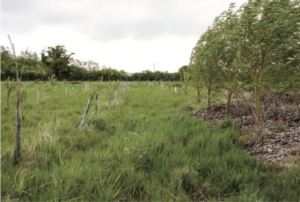
Willows mulched and unmulched, all planted at the same time in 2018, showing the striking effect of a deep mulch in a drought year.
WATER RETENTION
The other key use of mulches is to keep water in the soil where it is useful, rather than losing it to the air. It does this by shading the soil and thus lowering the temperature, and by protecting it from the wind, both of which reduce evaporation from the soil surface. Exact reductions in water loss will vary with system, mulch type, soil and climate.
As you would expect, the hotter and drier your climate, the greater the benefit is likely to be.
Plastic mulches give the same, if not greater, water retention but can create other problems. Solid films create an anaerobic environment under the mulch, which can lead to compacted and lifeless soil. Even the woven mulches, which do allow infiltration and some breathability, are not as good as an organic material for healthy soil. In wet climates slugs and snails can proliferate under plastic mulches where they have a safe, moist home away from most predators.
MODERATING SOIL TEMPERATURE
Using a mulch of any sort can help to warm cold soils and cool hot ones. The mulch gives protection to soil and plant roots, shielding it from extremes. It acts as winter coat, sunscreen lotion and umbrella combined.
As with water retention, there have been numerous studies looking at the effects of mulch on temperature. In many situations, plastic mulches will give higher temperature differences than organic materials. However, what I intend to illustrate in this book is that when looking at the multiple benefits a woodchip mulch gives you, it is worth sacrificing a little on water retention and temperature to get the long-term soil health benefits of woodchip mulches.
PHYSICAL DAMAGE
Bare soil is vulnerable soil. Mulching protects soil from physical damage such as heavy rain or wind, and in extreme weather conditions also helps to stop soil being washed or blown away. Woodchip mulches allow water to gently percolate through to the soil, whereas solid plastic mulches prevent the water from reaching the soil, instead causing localised flooding issues as the rain runs off the plastic. Wood-chip mulch even helps reduce damage from compaction caused by us walking or driving over the soil. The mulch cushions and absorbs our impact and keeps the soil in good condition underneath.
PEST AND DISEASES
Woodchip mulches have the potential to reduce some pests and diseases. Applied at the right time, they can cover over fungal spores on the soil and prevent them spreading when rain splashes back up onto the plant leaves. The mulch from some tree species will deter pests; for instance, cedar chip can help to keep termites and beetles away. New research in the UK has also been looking at using the salicylic acid in willow woodchip to stimulate an immune response in apples to help prevent scab.
However, we should also be aware of the risk of introducing some pests and diseases when using woodchip. We might be providing a perfect habitat for some insects and other invertebrates like woodlice. Though these are not usually major pests, they can, in some cases, cause crop damage. Similarly, there are tree diseases that might be present in woodchip that could cause problems in some circumstances. These risks can usually be managed but are worth keeping in mind.
PATHS
Woodchip is a great and versatile material to use for mulching paths. Because it is tough and doesn’t get damaged by our feet, it will easily last a season of being walked on. As it breaks down, you can either rake up and add to your compost heap or onto growing beds, or just lay another layer on top. The fungi and other organisms in the soil will help to move the nutrients and organic matter around your plot.
2. Propagation
Though composted organic material is often included in plant propagation mixes, it has not been so common to make use of woodchip for this purpose. There are commercial substrate manufacturers that use bark as the main ingredient for their products, but it is relatively easy to make your own plant-raising substrates from woodchip.
3. Mushrooms
If you have ever been into a woods or left an undisturbed pile of logs in the corner of your field, you will know that where there is rotting wood you will find fungi. Most of the mushrooms grown for human consumption live on wood in their natural environment. This gives us a big opportunity to bring mushroom cultivation into our use of woodchip. I am still very much at the beginning of my fungal journey, but I am experimenting with growing mushrooms in bags of wood- chip (which will of course be used again for something else when the mushrooms are done) and on the woodchip mulches in agroforestry systems.
4. Woodchip for Animal Bedding
Though not core to this horticultural-focused book, many gardeners will either keep some livestock, even if that is just a few chickens, or have access to farmer friends. It would be remiss of me not to have a brief look at the potential of woodchip as bedding for animals and the added benefit this gives to the subsequent material. Woodchip can soak up a lot of nitrogen and even outperform some traditional bedding materials, aiding animal health and welfare, and reducing leaching both from barns and from the resulting compost.
5. Soil Health Amendment
It’s hardly a news story that adding organic matter to soil is a good idea. Crop rotations with livestock, adding compost and muck spreading on farmland are all based on the principle that for a healthy, productive soil we need to add carbon and nutrients back into the soil to feed the organisms that live there. For some reason, though, we haven’t fully exploited the potential of woodchip for this purpose. This may be partly due to availability. Woodchip is a relatively new material; before woodchippers were invented, most woody waste would likely have been burnt, either harnessing the energy for fuel or just as a bonfire to dispose of the material. Tree surgeons now produce millions of tonnes of chip a year, and chippers are readily available to woodland managers and contractors. Some of this chip is a valuable commodity that can be sold to the biofuels industry, but much of it is lower grade, particularly where it has a high proportion of green bark and leaf material, though this might actually enhance its value for our purposes.
There are a few pioneers who recognised some time ago the power that woodchip can add to a growing system; people like Paul Gautschi, of documentary film Back to Eden fame, who advocates no-dig gardening, or Gilles Lemieux, whose cutting-edge research in Canada led to the coining of the term ‘ramial chipped wood’. However, there is now a growing understanding of the role that a range of organisms, but most notably fungi, can play in improving soil health and the part that woodchip has in this process.
Recommended Reads
Recent Articles
Wintergreen is the stunning evergreen groundcover that’s a game-changer for your garden! It’s cherished for its aromatic leaves, vibrant fall color & bright berries.
Read MoreGrow winter carrots for a sweeter & more flavorful harvest! Ditch the bland, store-bought carrots this winter! Grow your own winter carrots for a sweeter and more flavorful twist 🥕🥕
Read MoreSearching for the perfect book to give the homesteader in your life? We’ve got your go-to books for anyone interested in organic growing, permaculture, soil health, year-round growing & more! What’s their next great read?
Read MoreWinter is coming… but that doesn’t mean you should put away those tools just yet. Extend the growing season well past the first frost!
Read MoreThe dirty truth? Soil isn’t just dirt! It’s a complex web of life. Discover the secrets to unlocking its full potential and transform your garden forever.
Read More

